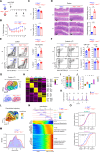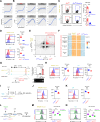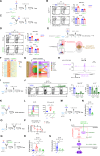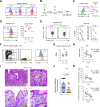Elevated nitric oxide during colitis restrains GM-CSF production in ILC3 cells via suppressing an AhR-Cyp4f13-NF-κB axis
- PMID: 40593752
- PMCID: PMC12216831
- DOI: 10.1038/s41467-025-60969-x
Elevated nitric oxide during colitis restrains GM-CSF production in ILC3 cells via suppressing an AhR-Cyp4f13-NF-κB axis
Abstract
Inflammatory bowel disease (IBD) presents a significant clinical challenge, yet the way bioactive gases are implicated remains elusive. We detect elevated colonic Nos2 levels in both IBD patients and mice undergoing diverse colitis. Additionally, Nos2 deficiency significantly aggravates anti-CD40-induced colitis, along with an increase in GM-CSF production by ILC3s. We identified a previously unappreciated role of the crucial ILC3 regulator, AhR, in promoting Cyp4f13 expression to allow ILC3s to bind with externally derived nitric oxide (NO). This further restrains Cyp4f13-catalyzed ROS generation and thereby diminishes NF-κB activation strictly necessary for GM-CSF production. Accordingly, the exacerbated anti-CD40-induced colitis due to defective NO generation in Nos2 deficient mice is efficiently recovered by a Cyp4f13 inhibitor, HET0016. Importantly, IBD patients with elevated NO binding to colonic ILC3s show decreased disease activity. Thus, our findings uncover a crucial regulatory mechanism for restraining colitogenic GM-CSF production in ILC3s and underscores its implication in IBD therapy.
© 2025. The Author(s).
Conflict of interest statement
Competing interests: The authors declare no competing interests.
Figures







References
-
- Mowat, A. M. & Agace, W. W. Regional specialization within the intestinal immune system. Nat. Rev. Immunol.14, 667–685 (2014). - PubMed
-
- Neurath, M. F. Cytokines in inflammatory bowel disease. Nat. Rev. Immunol.14, 329–342 (2014). - PubMed
-
- Kalantar-Zadeh, K., Berean, K. J., Burgell, R. E., Muir, J. G. & Gibson, P. R. Intestinal gases: influence on gut disorders and the role of dietary manipulations. Nat. Rev. Gastroenterol. Hepatol.16, 733–747 (2019). - PubMed
MeSH terms
Substances
Grants and funding
LinkOut - more resources
Full Text Sources
Molecular Biology Databases
Research Materials

